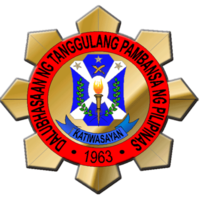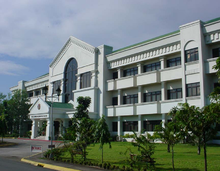- National Defense College of the Philippines
-
National Defense College of the Philippines Daluhasaan ng Tanggulang Pambansa ng Pilipinas
The NDCP SealMotto Katiwasayan (Security) Established August 12, 1963 Type Graduate; only program available: Master in National Security Administration (MNSA) President COMMO Carlos L Agustin AFP (Ret) (appointed October 15, 2001) Vice-president COMMO Francisco L Tolin AFP (Ret) MNSA (executive vice-pres), DR Nestor N Pilar (academic affairs), COMMO Mariano S Sontillanosa AFP (Ret) MNSA (research & special studies), BGEN Fredelino S Bautista AFP (Ret) (administrative affairs) Academic staff 10 Students approx. 40 Location
14°36′33″N 121°04′05″E / 14.6093°N 121.068°ECampus Urban Affiliations PMA Website www.ndcp.edu.ph The National Defense College of the Philippines (NDCP) (Filipino: Dalubhasaan ng Tanggulang Pambansa ng Pilipinas) (DTPP) is an educational, training, and research agency of the Philippine government responsible for providing continued and intensive studies of the diverse problems relating to national defense and security. It is under the Department of National Defense.
Contents
History
The National Defense College of the Philippines was first conceived in 1957 when the military advisors of the Southeast Asia Treaty Organization (SEATO) proposed the setting-up of a SEATO War College in the Philippines.
Cognizant of the need to establish a higher educational institution in the military that would be an institution at the zenith of the defense establishment where civilian-military cooperation for national security could be effectively forged, President Diosdado Macapagal signed Executive Order No. 44 on August 12, 1963, authorizing the establishment of the National Defense College of the Armed Forces of the Philippines (NDCAFP) and putting the College under the administrative and operational guidance of the AFP Chief of Staff. The College opened classes on February 15, 1966.
There were legislative moves to pass a law creating the National Defense College of the Philippines. In the House of Representatives, Congressman Manuel A. Zosa filed the House Bill No. 1420 in 1970 proposing an “Act Creating the National Defense College of the Philippines and for other Purposes.” Also in the same year, Congressman Ramon D. Bagatsing filed the House Bill No. 1447 proposing an “Act Creating the National Defense College of the Philippines, Providing an Academic Board, and for Other Purposes.” In the Senate, Senator Leonardo B. Perez filed the Senate Bill No. 597 proposing an “Act Creating the National Defense College of the Philippines and for other Purposes.” However, these legislative proposals did not reach third reading because President Ferdinand Marcos dissolved the Philippine Congress.
President Marcos subsequently issued Presidential Decree No. 190 in 1973 to formally create the NDCP to "fulfill the need for an institution that will provide for continuing and intensive studies of the diversified problems related to national defense and security." NDCP was then placed under the Office of the Secretary of National Defense in 1974 by virtue of P.D. No. 452.
The Academic and Admission Boards were later established to oversee the academic program of the College. To carry out its teaching function, the NDCP draws top experts from the academe and senior officers with command and staff experiences from the major services of the Armed Forces of the Philippines.
Lectures by foreign diplomats, technical experts and defense leaders also complement the instruction at the NDCP. The NDCP has managed to grow beyond its modest beginnings to train leaders in the military and civilian bureaucracy in strategic thinking.
On February 22, 1998, the College moved to its new and modern three-story building in the Academic Row, Camp Emilio Aguinaldo in Quezon City.
Master in National Security Administration Program
The Master in National Security Administration (MNSA) Program is the main academic program of the NDCP. It is a one-year, full-time master's degree course consisting of 39 units earned through various forms of classroom work, case studies, regional security and development studies and academic enhancement travels.
The MNSA curriculum focuses on the various dimensions of national security management:
- socio-cultural dimension
- political-legal dimension
- economic dimension
- techno-scientific dimension
- environmental dimension
- military dimension
The MNSA is open to military officers, government officials and private sector leaders. Students write a national security-oriented thesis. Civilian graduates are commissioned Lieutenant Colonels or Commanders in the AFP Reserve Force.
Strategic Research and Special Studies
Institute for National Security Studies
The Institute for National Security Studies (INSS) administers the research program of the NDCP. It embodies the College's effort to be the center of excellence in strategic thinking on national security matters in the Philippines and in the Asia-Pacific region.
Crisis Management Institute
The Crisis Management Institute (CMI), formerly the Emergency Management Institute of the Philippines (EMIP), is envisioned to be the country's center for education, training, and research on crisis management, terrorism, and other transnational crimes, and as the premier training resource for technical cooperation in emergency management in the Asia-Pacific region.
Defense Management Institute
The Defense Management Institute (DMI), formerly the Institute for Extramural and Continuing Studies (IECS), is envisioned to be the key training institution on certificate and diploma courses on National Security Administration and to be a recognized training institution in the Asia-Pacific.
Alumni Affairs
Many government and business executives have graduated from the MNSA program; they comprise the general membership of the NDCP Alumni Association. The NDCP has produced the following alumni:
- Fidel Ramos - former Philippine President and Secretary of National Defense
- Jejomar C. Binay, LLB, MNSA Vice President of the Philippines and former Mayor, Makati City
- Emmanuel Velasco, LLB, MNSA Cavite Provincial Prosecutor
- Ma. Alicia Austria-Martinez, LLB, MNSA - Associate Justice of the Philippine Supreme Court
- Gilbert Teodoro - former Secretary of National Defense
- Brigadier Gen. Manuel W. Manaligod - former Vice President of National Defense
- Daniel Martinez, LLB, MNSA - former Clerk of Court of the Philippine Supreme Court
- Loren Legarda - Philippine Senator and former broadcast journalist at ABS-CBN
- Teresa Aquino-Oreta - former Philippine Senator and former Malabon-Navotas Representative
- Herbert Constantine Bautista, MPA, MNSA - Quezon City Mayor
- Peter P. Ng, BSMT, MPH, MHA, GSC, MNSA, MD, FPAFP, LLB, PhD - Physician-Lawyer-Scientist. Medicolegal Practice.
- Jesus Edwin A. Villasor, AB, LLB, LLM, GSC, JCSC, MNSA, PhD Former Regional Trial Court Executive Judge and Retired Deputy Court Administrator at the Supreme Court
- Jose C. Vitug, AB, LLB, LLM, MNSA, FCJEI Former Associate Justice of the Supreme Court and now Chairperson of the Philippine Stock Exchange
- Gloria J. Mercado, AB, MNSA, PhD Dean, Development Academy of the Philippines
- Aida C. Talavera, BSC, MNSA Director, Commission on Audit
- Hilario S. Caraan, AB, LLB, MNSA, DPA Commercial Law Faculty and Discipline Director, De La Salle University
- Robert Dean Barbers - Former Chairman of the Philippine Tourism Authority.
External links
Department of National Defense, Philippines Executive Departments of the Philippines Sub-agencies Armed Forces of the Philippines · Government Arsenal · National Defense College of the Philippines · Philippine Veterans Affairs OfficeAFP Attached See also: list of Ministries of Defense by country Categories:- Department of National Defense (Philippines)
- Government of the Philippines
- Graduate schools in the Philippines
- Public policy schools
- Military schools
- Peace and conflict studies
- Research institutes in the Philippines
- Staff colleges
Wikimedia Foundation. 2010.


